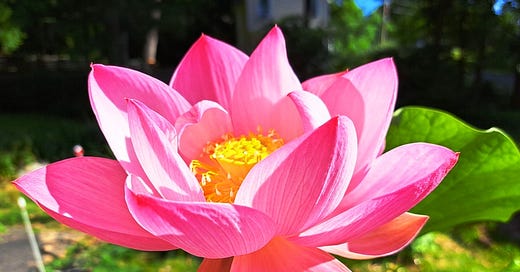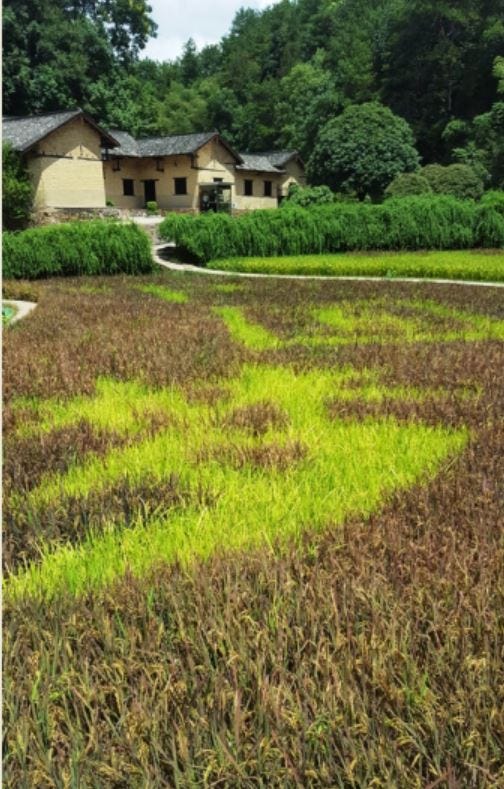The lotus-eaters in the Odyssey were a sybaritic tribe who were, it seems, stoned all the time. I don’t know what the Chinese think of this misnaming, since the lotus is important symbol of Buddhism and a significant foodstuff, and has no drug-like qualities. (Though of course all parts of the plant seem to have medicinal properties, as almost every food does in Chinese tradition.)
For me, lotus magic is the flower, which is blooming and reblooming here in Massachusetts on my deck. It has taken me a couple years figure out how to manage this tub gardening, but it’s actually very easy and I would love to see more people try it. Every morning when a new flower opens I’m taken back to an August day in Hunan, on a strange trip that included a visit to Mao Zedong’s home village, where the lotus was blooming in vast fields. Here are some photos:
It was during the pandemic, when I knew I wouldn’t be able to go to China for a while, that I begin thinking of those lotus fields. I purchased a lotus root by mail order, and for the first two years bought a new one each springtime. But last fall, I let the leaves die back and most of the water evaporate. I trim the dead stalks and hauled the tub to the basement, where it sat all winter, cool but not freezing. I did nothing except make sure the mud did not dry out.

In April or early May, we hauled the tub outside (it would be too heavy when full of water, but when it’s only mud this isn’t difficult). I added a few inches of water and some fertilizer, then hovered for weeks, and weeks, and weeks, waiting for a leaf. The leaf tips that come off the root are fragile so I really shouldn’t have been feeling around in the mud for signs of life.
As you can see, they came through the winter easily and are growing again happily. As soon as it became warm enough, sometime in May, the first leaf tip appeared. One after another they emerged, and then began to rise, followed by flower buds. They are heavy feeders so I pushed another a tablespoon of granular fertilizer, wrapped into a packet made from a bit of newspaper, into the mud at midsummer. And that’s it.
The one experiment I still want to do is to see if I can get start from a tuber bought at an Asian market – that would be much, much cheaper than a commercial grower. I’ve grown lemongrass this way, and I understand that big elephant-ear plants can be grown from a taro root in the produce section.
Lotus is a food plant. The leaves are used to wrap seasoned chicken for a classic dim sum treat. The nuts are made into a sweet paste stuffed into pastries and mooncakes. And the crunchy white root is good in stews or blanched and turned into a beautiful, simple salad. I’ll include a few references below.
The television series Bite of China has a brilliant piece in the first episode about lotus harvesting and the dishes made from lotus root. Because the tubers are fragile but have to be dug from heavy mud, it’s an extraordinarily labor-intensive process. You can find this on YouTube and it’s now available with English subtitles on Amazon Prime.
Lotus flowers begin to open at first light. I sometimes see four or five bumblebees ecstatically wriggling in the ring of gold and white pistils - pollinators, yes, and lotus-eaters.
Recipe notes
Lotus root is beautiful and stays firm when cooked, so I like to sub it into stews, even if not Chinese, if I happen to have some. I do used the vacuum-packed root slices because they are available in Great Barrington, but they are inferior to the fresh roots you can get at larger Asian markets (and no doubt at the supermarket near my childhood home in Cupertino).
“Sticky Rice Lotus Leaf Wraps” from the Woks of Life, one of my favorite Chinese cookery websites. These can be made with dried lotus leaves, or even parchment paper.
Many recipes in Fuchsia Dunlop’s excellent Every Grain of Rice require special ingredients, but she also includes simple dishes that can be made with things you’ll find at many supermarkets. Assuming you can get hold of lotus root, this one is super easy. Slice the peeled roots thinly, blanch for a minute and rinse in cold water. Dress with a mixture of rice vinegar, dark sesame oil, grated ginger, salt and a little sugar. Garnish with sliced green onion and sweet or hot red pepper slivers. She also suggested soaked dried shrimp and wood ear mushroom curls, but it’s a lovely salad without those additions. She writes, “The root, cut into slices, has an ethereal quality, with its crisp, crystalline flesh and snowflake pattern of holes.”










